
Last week the Sprengel Museum in Hanover announced that Pierre Huyghe had won the 2015 Kurt Schwitters prize. The French-born artist is no stranger to international recognition: he won the 2002 Hugo Boss Prize (awarded annually by the Guggenheim Museum), and a retrospective of his work at LACMA closed this month. While the retrospective in Los Angeles has struck some critics as a closed-loop of art-world elitism, his work remains—to this writer, at least—elusive and captivating.
The artist’s video installation Les Grands Ensembles (The Housing Projects) (1994/2001) was first exhibited publicly at the 2001 Venice Biennale, where it won a jury prize. I saw it in 2011, when an edition was put in a group exhibition at Gagosian Gallery, Los Angeles. My cousin and I stood in a small projection room for two loops of the 8-minute video, totally mesmerized.
The scene opens on a pair of darkened high-rise buildings in winter. The buildings are unremarkable: six columns of big picture windows over about a dozen floors, forming a regular grid on all sides. There are a few leafless trees and streetlights; the flat ground is covered in snow.
There is a guttural, undulating noise. At about 30 seconds in, some streetlights illuminate. A stagnant cloud of fog gives way to quickly moving gusts as the scene comes to life. The noise quickens and grows louder, more urgent. Rooms begin to illuminate; lights move in sequence across rooms and floors. Smoke fills the screen. More lights. With half the building’s rooms lit, a new sound redoubles over the first and creates the sense of an impending climax. At five minutes in, there’s a crash as lights begin to fly across surfaces, lighting both buildings in a dizzying blaze. Outside, it has begun to snow, and it grows dark again. At six minutes, the buildings take turns alternating light and dark; at seven, only the right remains in a bright web. Hearing a recording online, a friend aptly described the relentless sound as an underwater buzz coming to the surface for air. In person, it was terrifying.
And yet, the whole thing borders almost imperceptibly on kitsch. Huyghe’s Modernism is not self-serious, like Le Corbusier’s manifesto Toward An Architecture (1923), but eerie and funny, like the squeaky black-leather chairs of Jacques Tati’s Playtime (1973). If Huyghe’s scene recalls Thomas Demand photographs of meticulously-constructed paper models, it also looks like a giant game of Pac-Man or Pong. The whole thing is a creative reworking of a scene from Godfrey Reggio’s film, Koyaanisqatsi (1982).
Reggio tracked the demolition of the Pruitt-Igoe housing project in St. Louis. Designed by Minoru Yamasaki (who would later design the World Trade Center towers), the complex of nearly 3,000 apartments in 33 buildings was built in 1954. The buildings were not properly maintained and by 1971, conditions at the complex had deteriorated so heavily that 16 of the buildings sat vacant. That year, two of the buildings were demolished. The rest were brought down over the next few years, the site cleared in 1976. The project would come to be seen as a controversial political (and architectural) failure.
In a seven minute sequence, Reggio’s camera circles Pruitt-Igoe overhead. The complex is by now a graveyard of giant tombstones on overgrown grounds. Closer shots of the sites where buildings have already been brought down show an ocean of tan bricks and broken glass. Neither shot gives an indication of when the buildings were last inhabited; it seems they never were.
Like Housing Projects, Koyaanisqatsi depends heavily on the power of its soundtrack, composed by Philip Glass. In both, a pulsating rhythm brings remarkable energy and drives the action. In both, there is then the inextricable play of mediums: film capturing architecture (real and imagined), set to palpable sound.
How each scene concludes gives evidence of the differences at play. Eventually, Pruitt-Igoe disappears behind a cloud of smoke as detritus from the explosion flies toward the camera. The conclusion is one of climactic, fundamental destruction. In Housing Projects, the apartments dim, the sound dissipates, and a fog slowly rolls in. Huyghe’s anti-climax leaves the buildings as we first saw them. If “Modern architecture died in St. Louis, Missouri” with Pruitt-Igoe’s fall, as architect Charles Jencks put it, Huyghe resurrects it for a few minutes, in a game of his own devising.